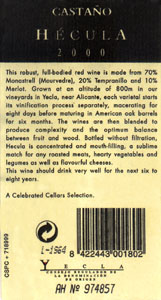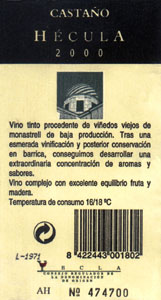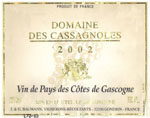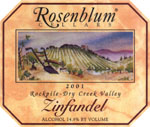![]()

Get
all the evaluations for
the MAY
Release
Subscribe
to Vintage Assessments today
by Clicking
Here
This
not-for-profit website is dedicated to the discerning reader!
The
Numbers Game
Only the lot number reveals what you are buying!
National Post Weekly Wine & Spirits Columnist
Saturday, May 31, 2003
It’s hush-hush, something you rarely read about. It has to do
with all those often hard-to-read numbers that appear on different parts
of a wine bottle. They may be appear anywhere: the back or front label,
the capsule, the back of the front or back label, on the glass itself or
even the top of the cork under the capsule. While one might be tempted to
think who cares, these are the numbers revealing whether you are actually
getting the wine you want.
In fact, most wines now have three sets of numbers. First and
foremost, we have the six-digit CSPC (Canadian Standard Product Code) - a
number arbitrarily allocated to a wine by the LCBO. This is the number
that you and I use when buying a wine in Ontario. At one time the LCBO
required that it appear on all bottles sold in Ontario. In fact, it was a
system that was pretty much used by liquor boards right across Canada. One
of the key problems confronting the LCBO was that they started running out
of numbers and began recycling these numbers, much to the general
confusion of everyone. As a result and with the advent of bar coded
labels, which is almost universally used by producers to identify their
brands, the LCBO dropped compulsory CSPC numbering, although still use
them to identify products.

While all of this is important in making sure you get the right
wine, it was only relatively recently that the EEC became increasingly
concerned with the need to track down specific bottles in the event of
glass contamination or other qualitative problems. This is especially
important when confronted with huge quantities of seemingly homogeneous
non-vintage dated blends. As a result, all beverage products sold in the
EEC today must now have a bottling code.
In fact, this information is the only way of determining whether a
previously-tasted and/or released wine is the same as what you are buying
today. It is, of course, not unusual for less expensive blends to
incorporate a new vintage meaning that there will always be some stylistic
changes.
When it comes to better, vintage-dated wines, however, I have been
astonished to discover that occasionally there is little in common with
what was tasted before. There are three possible reasons for this. First,
flavours naturally evolve as a wine ages. Sometimes these changes
–better or worse - are totally out of sync with the natural aging
process. When the quality has fallen through the floor, for instance, poor
shipping and/or storage conditions (both in transit and here in Ontario)
are probable culprits. A skid of whites sitting in a baking hot rail car
or truck for a week or so can be a very damaging (although the real
consequences often do not appear until 6-9 months after the trauma). This
is the second source of unanticipated variation.
Unfortunately, it can go far beyond this. Identical vintage-dated
wines (with the same CSPC and bar code) may be totally different bottlings.
In some instances, these individual batches can reflect substantial
variations in vinification, and even, the final blend. Under such
circumstances, the wine is simply not the same.
A worst-case scenerio occurred last January when I rang the alarm
on what was supposed to be a Spanish stunner - a red that both Robert
Parker and I had tasted and raved about. Unfortunately, what arrived here
at the LCBO was not up to snuff. It immediately became evident that these
were totally different batches with separate bottling codes.
 back label from LCBO bottle |
 back label of the original bottle |
As a result, I now document the lot number (assuming I can find it)
for every wine I taste. Certainly it is crucial for buyers to know what
they are buying. In this vein, it’s a shame that we do not have the same
regulations here in Ontario. Compulsory lot numbers would enable consumers
to immediately distinguish between different bottlings of
identically-labeled wines. Right now, you have no way of knowing if the
wine is really the same. Certainly when it comes to non-vintage-dated
wines, who knows how long they have been sitting around? Wine is like any
perishable food product and should be treated accordingly.
 In
next Saturday’s Vintages release is one of my consistent favourites that
puts a delicious spin on the warm summer weather. Don’t miss Domaine
Des Cassagnoles 2002 a steal at only $8.95 (931212). This Vin de Pays des Côtes de
Gascogne is wonderfully fragrant with dry, crisp, slightly grassy, ripe
peachy-pear flavours that literally jump out of the glass. Ironically this
100% Colombard is easily mistaken for a Sauvignon Blanc, indeed it puts
many high-priced Sauvignon Blancs to shame. It hails from the Armagnac
region in southwestern France and is now at its peak of enjoyability. One
of the best value whites to hit the Vintages shelves this year, 1,410
cases are available. Cottagers are reminded that 11 am Tuesday, June 3rd
is the LCBO cut-off time for out-of-town orders.
In
next Saturday’s Vintages release is one of my consistent favourites that
puts a delicious spin on the warm summer weather. Don’t miss Domaine
Des Cassagnoles 2002 a steal at only $8.95 (931212). This Vin de Pays des Côtes de
Gascogne is wonderfully fragrant with dry, crisp, slightly grassy, ripe
peachy-pear flavours that literally jump out of the glass. Ironically this
100% Colombard is easily mistaken for a Sauvignon Blanc, indeed it puts
many high-priced Sauvignon Blancs to shame. It hails from the Armagnac
region in southwestern France and is now at its peak of enjoyability. One
of the best value whites to hit the Vintages shelves this year, 1,410
cases are available. Cottagers are reminded that 11 am Tuesday, June 3rd
is the LCBO cut-off time for out-of-town orders.
On the home front, I have been reminded to mention their upcoming
BBQ Zin promotion taking place this Wednesday, June 4th at $50
a head (see my web site for details). I love good Zin, the emphasis being
on the word “good”. While Zin comes in a variety of styles and
flavours (basically something for everyone), some recent releases are
sweetish and monotonal with marischino cherry and tropical fruit cocktail
flavours. While I admit that they can take on a life of their own, say
when served with sweet, smoky bbq ribs, good ones are increasingly hard to
find.
 Certainly that is the case with the 18 Zins (ranging in price from
$15.45 to $39.65) in next Saturday’s Vintages release. Two-thirds come
from the 2000 vintage, which the Wine Spectator says is “somewhat one dimensional, lacking depth, concentration and the range
of flavours that make Zinfandel such an interesting and unique wine.”
The best of the bunch by far is 2001
Rosenblum Rockpile Road Vineyard (502336) that fetches $39.65.
Certainly that is the case with the 18 Zins (ranging in price from
$15.45 to $39.65) in next Saturday’s Vintages release. Two-thirds come
from the 2000 vintage, which the Wine Spectator says is “somewhat one dimensional, lacking depth, concentration and the range
of flavours that make Zinfandel such an interesting and unique wine.”
The best of the bunch by far is 2001
Rosenblum Rockpile Road Vineyard (502336) that fetches $39.65.
Finally, my best buy of the week. If you like Zin’s spicy,
supple, ripe cherry-berry fruit flavours, you going to love Calama
2001 Merlot (612440) at only $9.00 on the General List. It may not taste like a
Merlot, but it is delicious and ready to enjoy.
Subscribe to Vintage Assessments Today • Click Here
|
Vintages July 2003 Release
|
Copyright Food & Beverage Testing Institute of Canada
2004
Prior written permission is required for any form of reproduction
(electronic or other wise) and or quotation.
Contact Michael Vaughan at
mbv@total.net